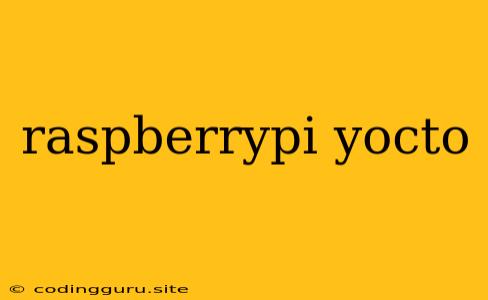Embark on a Custom Embedded Journey with Raspberry Pi and Yocto: A Comprehensive Guide
The Raspberry Pi is a renowned platform for embedded systems and maker projects. Its versatility and affordability have attracted a wide range of users. However, when your project demands a highly tailored, optimized, and robust operating system, the default Raspbian might not be the optimal choice. Enter Yocto Project, a powerful, open-source framework designed to create custom Linux distributions tailored to specific hardware.
This guide will delve into the exciting possibilities of combining the Raspberry Pi with the Yocto Project, enabling you to build highly customized embedded systems for a wide array of applications. We'll explore the key concepts, benefits, and step-by-step instructions to help you navigate this powerful combination.
Why Choose Yocto for Your Raspberry Pi Project?
- Customization: The Yocto Project allows you to precisely select and configure components, libraries, and packages, resulting in a lean and optimized OS perfectly aligned with your project's needs.
- Cross-Compilation: Develop your embedded system on a different computer (like your laptop) and cross-compile the entire system for your Raspberry Pi, simplifying the development process.
- Version Control: Easily manage dependencies and track changes to your system configuration, ensuring reproducibility and consistency.
- Community Support: The Yocto Project boasts a vibrant community with extensive documentation, forums, and support resources available to help you through any challenges.
Getting Started with Raspberry Pi and Yocto
-
Prepare Your Development Environment:
- Install the necessary tools, including Python 3, Git, and a suitable cross-compiler (such as GCC).
- Download and install the Yocto Project (e.g., Poky distribution) on your development machine.
-
Create a Yocto Project Configuration:
- Navigate to your desired project directory.
- Create a configuration file (e.g., "local.conf") to customize your build environment.
- Define essential parameters, such as the target machine (Raspberry Pi), the desired kernel version, and specific packages to include.
-
Set Up Your Raspberry Pi Target:
- Connect your Raspberry Pi to your development machine via a network connection.
- Ensure the Pi is running in a bootable state (e.g., with a standard SD card image).
-
Build the Custom Image:
- Use the Yocto Project build system to generate the custom image for your Raspberry Pi.
- This involves compiling the kernel, libraries, and applications, all based on your configuration.
-
Deploy the Image to Your Raspberry Pi:
- Once the image is built, transfer it to your Raspberry Pi (e.g., using network file transfer protocols).
- Flash the image onto the SD card, replacing the existing Raspbian or any other operating system.
A Simple Example: Building a Minimal Linux Image
Let's demonstrate a basic example of building a custom Linux image for your Raspberry Pi using the Yocto Project:
- Create a configuration file (local.conf):
# Define the machine target
MACHINE = "raspberrypi4"
# Select a specific kernel version
KERNEL_VERSION = "5.10"
# Define the target image
IMAGE_FSTYPES = "ext4"
- Execute the build command:
bitbake core-image-minimal
This will create a minimal Linux image specifically tailored for your Raspberry Pi. This image will include only the essential core components necessary for a basic operating system.
Building a Customized System
You can extend this simple example to create more complex and customized systems by:
- Selecting packages: Include specific packages (like network utilities, graphics drivers, or even custom applications) in your configuration file.
- Modifying recipes: The Yocto Project uses recipes to manage and configure individual packages. You can modify existing recipes or create new ones to customize software behavior.
- Integrating third-party libraries: Include libraries you've developed or obtained from external sources into your custom image.
Advantages and Considerations
Building a custom embedded system with Yocto Project offers significant advantages, including:
- Security: Control the software running on your Raspberry Pi, minimizing vulnerabilities and ensuring security compliance.
- Performance: Optimize your system by only including the essential components, improving efficiency and resource utilization.
- Specific Hardware Support: Build images for different Raspberry Pi models (Pi 3, Pi 4, etc.), customizing them to take advantage of specific hardware capabilities.
- Long-Term Support: Ensure a consistent and reliable software environment, reducing the impact of software updates and version compatibility issues.
However, it's important to consider the increased complexity involved in managing the Yocto Project build process compared to using standard Raspbian.
Conclusion
The combination of Raspberry Pi and Yocto Project opens a world of possibilities for building highly customized and optimized embedded systems. This guide has provided a foundation for understanding the key concepts, getting started, and building your own custom images. Whether you're developing a specialized robotics project, an IoT application, or any other embedded system, Yocto Project empowers you to take control of your hardware and software, unlocking a new level of flexibility and efficiency in your Raspberry Pi projects.
